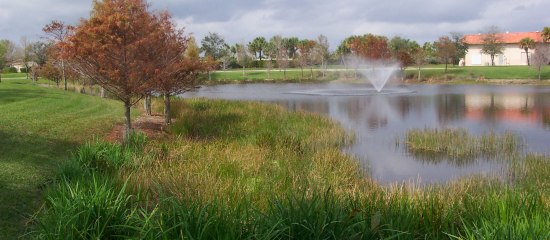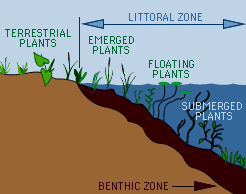 Back to Permitting and Regulation
Back to Permitting and Regulation Lake Excavation

Excavation in South Florida is done to extract fossilized shell to make concrete, acquire fill for construction and to store water. If lakes and mines are dug too deep with poorly sloped edges, they can be hazardous to people and result in poor water quality, harming the surrounding environment. Since 1992, ERM has regulated excavation and mining through the Palm Beach County Unified Land Development Code (ULDC) Article 4, Chapter B, Section 10, Excavation Uses.
ERM has increased health and safety, prevented erosion and loss of property, increased water quality and provided habitat by regulating excavation.
Frequently Asked Questions
 -
What are littoral zones?
Also called the intertidal zone, the area near the shoreline where sunlight is able to penetrate the sediments and characterized by abundant dissolved oxygen, nutrients, generally high wave energies and water motion, and alternating submergence and light exposure. It is the optimal region for aquatic plants to grow. -
Why are they good?
Retention lakes act like a sink holding storm water that drains from surrounding areas. Native aquatic plants growing in the littoral zone
reduce erosion by stabilizing the banks, increase water quality by taking up excess nutrients and provide habitat for wading birds and other wildlife. -
Which lakes need a littoral zone?
In unincorporated Palm Beach County
lakes greater than 1 acre OR deeper than 6 feet require a permit from ERM prior to excavation. The permit requires developers to install a planted littoral zone consisting of five different aquatic plant species. Native plant coverage is required to reach 80% by 180-days and have less than 10% exotic/invasive species.
Can I remove littoral plants?
It is not allowed to remove and/or cut back littoral plants in a regulated lake within the Restrictive Covenant Agreements’ (RCA) Area of Record. If a property owner wishes to cut back littoral plants that have grown outside the Area of Record, they must first get approval by ERM. Please keep in mind, a required 5’ buffer extends beyond the littoral shelf to provide stability and prevent shelf erosion.
Who is responsible for lake maintenance?
The owner (examples include property management businesses, homeowner associations, golf course managers, & municipalities ) of the lake are all required to maintain the lake and the littoral zone in perpetuity and should have an agreement with a licensed contractor to do so.
Important Reminders
Littoral plants go dormant in the winter.
Multiple
lake systems may consolidate plantings.
20 foot maintenance easement around each lake.
The following entities also
govern excavation:
 Palm Beach County Planning and Zoning
Palm Beach County Planning and Zoning
 Palm Beach County Health Department
Palm Beach County Health Department
 South Florida Water Management District
South Florida Water Management District Topics of Concern
Algae
-
In moderate amounts, algae help with the productivity and are essential for a healthy lake.
-
If the water is not being managed, growth can become out of control resulting in an algal bloom.
-
Often referred to as "slime", "scum", or "sludge", blooms range in color from green to brown, and have various textures and consistencies.
-
Algae blooms are very common in Florida’s water systems, especially during the spring and summer months.
-
Nutrient rich water that collects in a lake can result in an algae bloom as the storm water flowing into the lake carries phosphorus, the main nutrient that controls the amount of algae.PHOSPHORUS = ALGAE GROWTH
-
Blooms can become harmful because they block sunlight from reaching the bottom resulting in the death of plants and fish. Extreme cases can result in a fish kill and/or a “dead lake”.
Dead Fish
-
Most fish kills result from low concentrations of dissolved oxygen (DO) in the water.
-
Factors such as algae blooms (as mentioned above), drought, overpopulation, and water temperature can all affect the DO levels.
-
Warm water holds less dissolved oxygen than cold water, so summer is the time when fish can have a hard time getting enough oxygen.
-
In Florida, on warm summer nights during algal blooms, the dissolved-oxygen concentration sometimes drops too low for the fish, and a die-off can occur.
-
Low dissolved oxygen can result from other factors, too, such as poor flushing or circulation, dredging, or a sudden rain after a dry spell.
-
It is important to keep the water aerated via a fountain or other aeration devices.
-
Toxicity, infectious diseases, and parasites are possible but far less common causes of a fish kill.
Mosquitoes and Midges -
Two types of flying insects that require water to complete their life cycles are mosquitoes and midge flies.
-
Midge fly larvae also called bloodworms live in the bottom of the lake.
-
Midge fly adults often fly in large swarms in early evening but
DO NOT BITE.
-
Mosquito larvae also called wrigglers live just below the water surface.
-
Mosquito adults will bite and can transmit diseases.
-
If you are concerned that you have mosquitoes breeding in your lake,
ERM's Mosquito Control Division may be able to assist you.
|